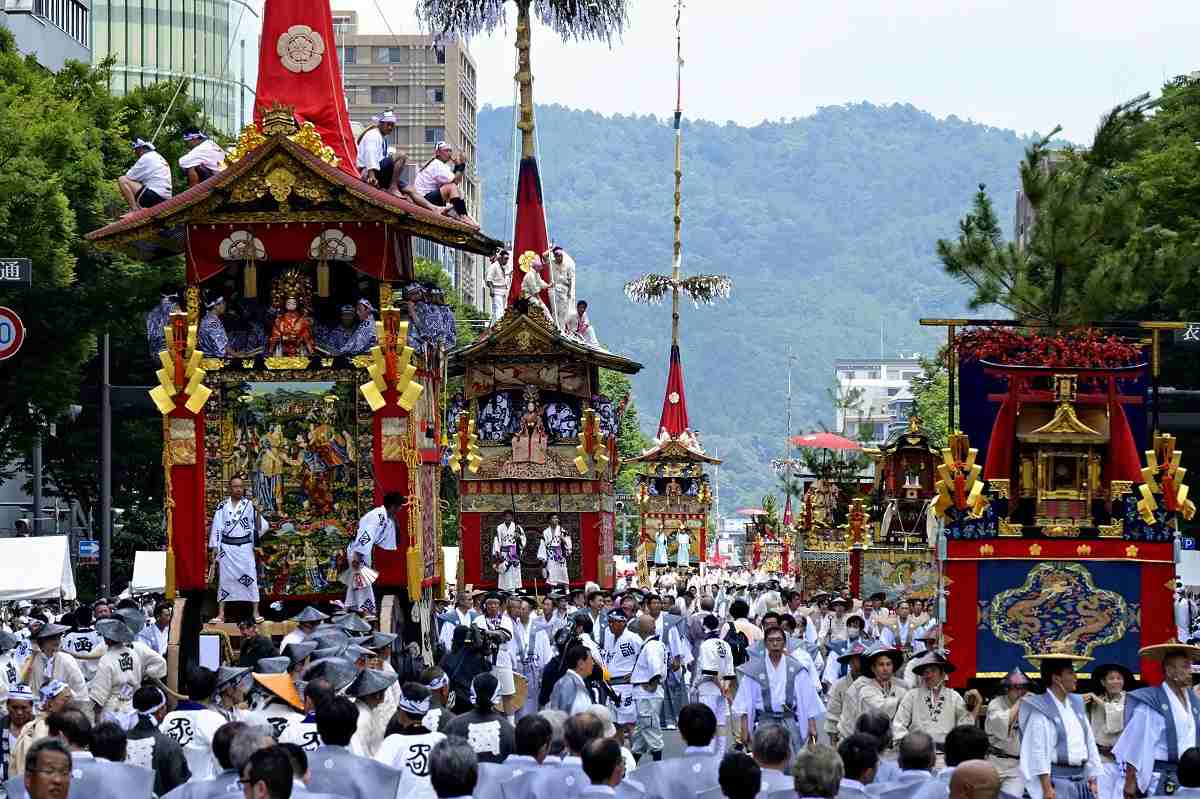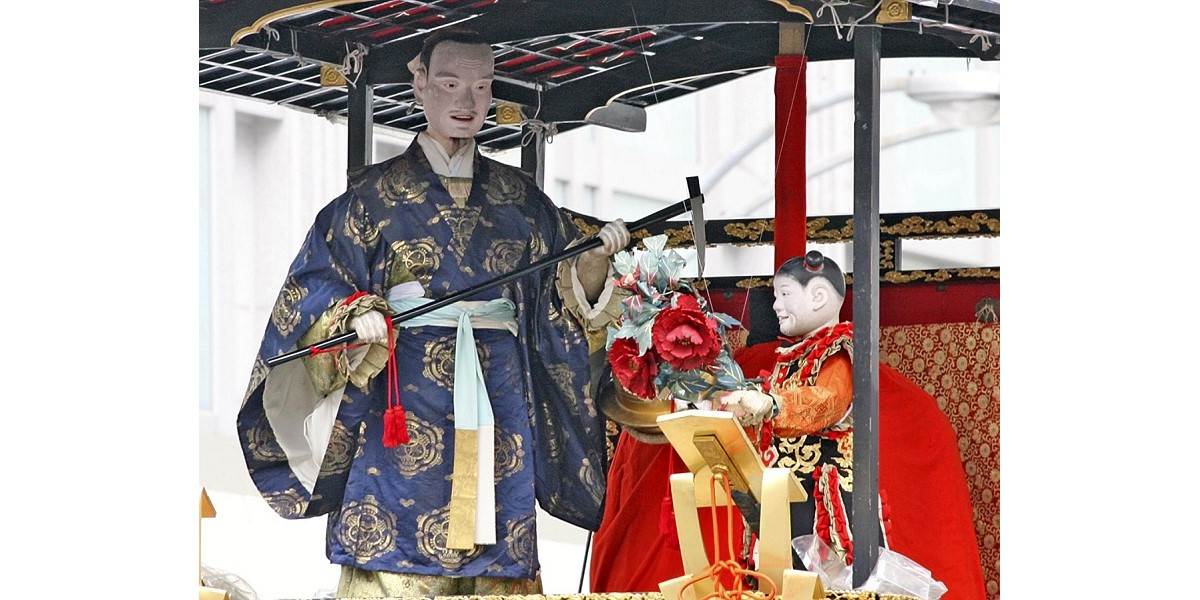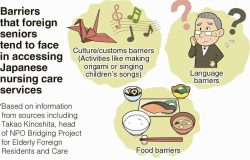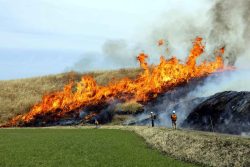
Floats parade down the main street in the Gion Festival in Nakagyo Ward, Kyoto, on July 17 last year. Each community has been handed down one float, which local residents pull with ropes or carry if they are small.
11:40 JST, July 10, 2023
Ancient Japanese politics, society and culture were sometimes influenced by curses and hauntings. Last month, this column related that the relocation of Japan’s capital to Heiankyo was carried out in order to escape hauntings. This time, let me focus on the Gion Festival in Kyoto, which certainly is excellent material for getting familiar with Japanese religion, art and performing arts.
The Gion Festival began in 869, 75 years after the capital was relocated to Kyoto. Sixty-six hoko spears, or hilts attached to double-edged swords, were erected in Shinsenen, the Emperor’s garden, in Nakagyo Ward. The garden has since been reduced to a temple. This is said to be how the festival started.
This may sound a bit ominous, but spears were often used for ceremonial purposes from olden times.
Sixty-six was the number of provinces at that time. These provinces were local administrative divisions used prior to the Meiji era (1868-1912), and their names remain part of place or station names. For instance, Saitama Prefecture, Tokyo and a part of Kanagawa Prefecture formerly belonged to the Musashi-no-kuni province. Therefore, many places and stations still contain “Musashi” as part of their names today.
Kyoto Prefecture consists of the former Yamashiro-no-kuni, a part of the Tamba-no-kuni, and the former Tango-no-kuni. The size of the provinces around the capital, which had a high population density, was small.
But I’ve got off track a little.
The year 869 saw a series of epidemics and disasters across Japan. The Tohoku region was struck by the Jogan Earthquake, comparable in scale to the Great East Japan Earthquake of 2011. The quake also caused tsunami. In Heiankyo, with an estimated population of about 100,000, epidemics broke out in the hot and humid summer. People believed that these were all caused by the god of curses.
Why did they erect hoko spears?
“The god is usually believed to be in the mountains. But people welcomed the god to the town, calmed him down and exorcised him,” said Tetsuo Yamaori, a religious scholar and professor emeritus at the International Research Center for Japanese Studies. “The branches of pine trees and sakaki evergreens, which were called yorishiro, were used as markers for welcoming the god, and these were believed to have later transformed into spears.”
As time went by, spears began to be mounted on carts, which are known as yamahoko floats today. The most spectacular part of the Gion Festival is the procession of floats through the city. The festival takes places annually, on July 17 and 24.
Most yamahoko floats carry a sacred object on their carts. The objects come in a huge variety of shapes, ranging from a super-powerful politician in ancient Japan and a military commander who was an excellent poet, to a legendary Chinese commoner famous for filial piety. The power of their stories is used to appease and exorcise the god of curses.

The deity on the Kakkyoyama float represents a Chinese tale of filial piety.
Some floats are covered with tapestries of Western origin. Many of them were imported during the Edo period (1603-1867).
For example, the tapestry of the Kankoboko float depicts a man receiving a large jar from a woman and a man giving a bracelet to a woman. The scene is said to be that of Isaac choosing his bride from the Book of Genesis in the Old Testament.
Christianity was forbidden during the Edo period, but the float with a scene from the Bible apparently paraded around the town back then.
“The jar is so big that it looks like it’s filled with alcohol, so people apparently misunderstood that it was the most suitable design for a festival,” said a member of the society for the preservation of the Kankoboko float.
A tapestry featuring the Trojan War is used in another float. Tapestries like this are believed to be the result of wealthy merchants who supported the festival using the floats to try to show off their financial power.
Today, the Gion Festival is often referred to as a tourist attraction, but it should be remembered that the festival started from people’s fear about curses and divine punishment.

Right: The tapestry used as the front hanging of the Kankoboko float is based on an episode from the Book of Genesis in the Old Testament.
Left: Floats parade down the main street in the Gion Festival in Nakagyo Ward, Kyoto, on July 17 last year.
"JN Specialities" POPULAR ARTICLE
-

The Japan News / Weekly Edition (12/12-12/18)
-

English-language Kabuki, Kyogen Entertain Audiences in Tokyo; Portland State University Professor Emeritus, Graduates Perform
-

Noodle Dining Shunsai / Rich Oyster Ramen to Savor at Odasaga; Experienced 68-year-old Owner Creates Numerous Ramen Varieties
-

The Japan News / Weekly Edition (12/5-12/11)
-

People Keep Loved Ones’ Ashes Close in Special Jewelry, Small Urns as Unique Way to Memorialize Them
JN ACCESS RANKING
-

Keidanren Chairman Yoshinobu Tsutsui Visits Kashiwazaki-Kariwa Nuclear Power Plant; Inspects New Emergency Safety System
-

Imports of Rare Earths from China Facing Delays, May Be Caused by Deterioration of Japan-China Relations
-

University of Tokyo Professor Discusses Japanese Economic Security in Interview Ahead of Forum
-

Japan Pulls out of Vietnam Nuclear Project, Complicating Hanoi’s Power Plans
-

Govt Aims to Expand NISA Program Lineup, Abolish Age Restriction






















